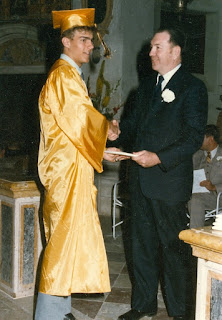I’ve been going through a lot of old
photos lately, throwing away many ones that are unfocused, too light or dark, show
only the back of people’s heads or bottoms, and just plain poorly composed. It
has made me think about what makes a good photograph—and why.
In these incidents, I’m not talking
about professional photographs, but just ordinary people, and how the same “elements”
of photography are the same rules of life.
 Correct lighting: Here I’m thinking of the correct light exposure,
too dark or too light, but it applies to our lives also. Light is one of the
most effective tools of a photographer, and it is important we have the light
of Christ in our lives. Christ is never too bright or overwhelming, but
lightens our lives; it illuminates, but does not dominate.
Correct lighting: Here I’m thinking of the correct light exposure,
too dark or too light, but it applies to our lives also. Light is one of the
most effective tools of a photographer, and it is important we have the light
of Christ in our lives. Christ is never too bright or overwhelming, but
lightens our lives; it illuminates, but does not dominate.
Focus: The next obvious tool is to be focused! I have
boxes of unfocused, blurry photos that I wish I could undo and retake, but
fortunately life allows us numerous retakes. It is important to simplify our
lives and be focused on what is important and not waver. There isn’t often time
to do all the things we want in this lifetime (those some of us still try to do
it), but we must concentrate and focus clearly on those things of most worth—our
family, living a good life, being a good person. If not our whole life will be
blurry and unproductive.
Frame your photo; isolate the main subject from the outside world. This
is so much like the focus element; don’t clutter your background or life with
so much “junk” you can’t see what is important.
Contrast: This goes back
to light, but it is important to see the contrasts in our life—to realize that
there is good and bad, and if we can see them clearly, we can choose the light
that is best.
Perspective: In a photo,
perspective leads our eyes to the focus of the picture; in life, perspective
allows us to see where we are going and to adjust to get where we want to be.
Composition: There are some important elements of composition,
but they all place the most important feature of the picture in the center of
our eye’s view, although it can be done in different ways:
1. Foreground; In a photo, it is important to place the most important element in the
foreground, so it doesn’t get lost in the background. It is important in our
life to place the most eternally important aspects of our life in the
foreground; we can’t spend our life playing video games and expect to get
anywhere (unless we design video games).
2. Leading Lines: This is a technique where the natural lines of nature pull our eyes to
the most important element of our photo; in this case, we don’t need it in the
foreground because “all roads lead to Rome,” or all aspects of our life show
our focus on the most important things in life.
3.
“Rule of Thirds”: The theory is that if you divide a photo into thirds diagonally and horizontally, you place points of interest in the intersections or along the lines so that your photo becomes more balanced. This will enable a viewer of the image to interact with it more naturally.
“Rule of Thirds”: The theory is that if you divide a photo into thirds diagonally and horizontally, you place points of interest in the intersections or along the lines so that your photo becomes more balanced. This will enable a viewer of the image to interact with it more naturally.
Now I’ll put away my photos, laughing at all the poor
photos I’ve taken through the years, but hoping each day to do better.
















No comments:
Post a Comment